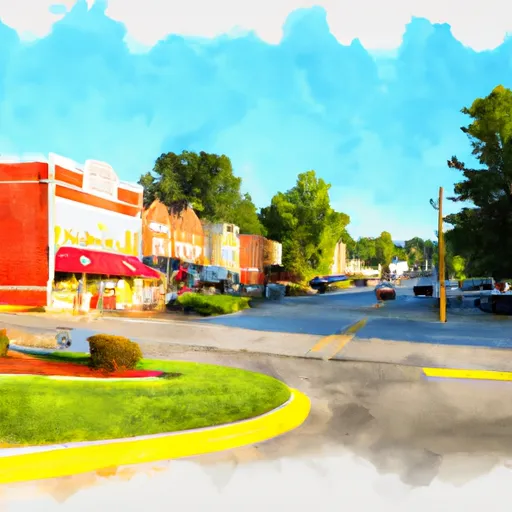-
 Snoflo Premium
Snoflo Premium
Get unlimited access to all our content
With no Ad interruptions! - Start Your Free Trial Login with existing account
Millwood
Eden Index
Climate
7.8
•
Recreation
4.5
•
Community
•
Safeguard
4.7/10

Millwood, Kentucky is a small town situated in Grayson County. The climate in Millwood is characterized as a humid subtropical climate, with hot and humid summers and mild winters. The average temperature in summer ranges from 70°F to 90°F, while winter temperatures typically range from 30°F to 50°F. Precipitation is evenly distributed throughout the year, with an average rainfall of around 48 inches annually.
The hydrology of Millwood is primarily influenced by the Rough River Lake, which borders the town. This picturesque lake offers various recreational opportunities, including boating, fishing, swimming, and water skiing. With an abundance of largemouth bass, bluegill, catfish, and crappie, it is a haven for fishing enthusiasts. The lake's serene surroundings also make it an ideal spot for camping, picnicking, and hiking.
Apart from the lake, Millwood is surrounded by lush greenery, providing ample opportunities for outdoor activities such as hunting, birdwatching, and nature walks. The diverse flora and fauna in the area make it an attractive destination for nature enthusiasts. Overall, Millwood offers a tranquil environment for outdoor recreation, making it an appealing location for nature lovers and those seeking respite in nature's beauty.
What is the Eden Index?
The Snoflo Eden Index serves as a comprehensive rating system for regions, evaluating their desirability through a holistic assessment of climate health, outdoor recreation opportunities, and natural disaster risk, acknowledging the profound impact of these factors on livability and well-being.
Climate Health Indicator (CHI): 7.8
Millwood receives approximately
1320mm of rain per year,
with humidity levels near 83%
and air temperatures averaging around
14°C.
Millwood has a plant hardyness factor of
6, meaning
plants and agriculture in this region thrive during a short period during spring and early summer. Most
plants will die off during the colder winter months.
By considering the ideal temperature range, reliable water supplies, clean air, and stable seasonal rain or snowpacks, the Climate Health Indicator (CHI) underscores the significance of a healthy climate as the foundation for quality living.
A healthy climate is paramount for ensuring a high quality of life and livability in a region, fostering both physical well-being and environmental harmony. This can be characterized by ideal temperatures, reliable access to water supplies, clean air, and consistent seasonal rain or snowpacks.
Weather Forecast
Streamflow Conditions
Green
Area Rivers
Green
Snowpack Depths
Green
Reservoir Storage Capacity
Green
Groundwater Levels
Recreational Opportunity Index (ROI): 4.5
The Recreational Opportunity Index (ROI) recognizes the value of outdoor recreational options, such as parks, hiking trails, camping sites, and fishing spots, while acknowledging that climate plays a pivotal role in ensuring the comfort and consistency of these experiences.
Access to outdoor recreational opportunities, encompassing activities such as parks, hiking, camping, and fishing, is crucial for overall well-being, and the climate plays a pivotal role in enabling and enhancing these experiences, ensuring that individuals can engage in nature-based activities comfortably and consistently.
Camping Areas
| Campground | Campsites | Reservations | Toilets | Showers | Elevation |
|---|---|---|---|---|---|
| Monte Sano State Park | 104 | 1,608 ft | |||
| Barton Springs - Normandy Lake | 67 | 885 ft | |||
| Cedar Point - Normandy Lake | None | 882 ft | |||
| Poole Knobs - J. Percy Priest Reservoir | 88 | 537 ft | |||
| Marshall County Park | None | 598 ft | |||
| Cathedral Caverns State Park | None | 643 ft | |||
| Lake Guntersville State Park | 366 | 630 ft | |||
| Ditto Landing City Campground | None | 567 ft | |||
| Sharon Johnston Park | 33 | 771 ft | |||
| Tims Ford State Park | 52 | 936 ft |
Nearby Ski Areas
Catastrophe Safeguard Index (CSI):
The Catastrophe Safeguard Index (CSI) recognizes that natural disaster risk, encompassing floods, fires, hurricanes, and tornadoes, can drastically affect safety and the overall appeal of an area.
The level of natural disaster risk in a region significantly affects safety and the overall livability, with climate change amplifying these risks by potentially increasing the frequency and intensity of events like floods, fires, hurricanes, and tornadoes, thereby posing substantial challenges to community resilience and well-being.
Community Resilience Indicator (CRI):
The Community Resilience Indicator (CRI) recognizes that education, healthcare, and socioeconomics are crucial to the well-being of a region. The CRI acknowledges the profound impact of these elements on residents' overall quality of life. By evaluating educational resources, healthcare accessibility, and economic inclusivity, the index captures the essential aspects that contribute to a thriving community, fostering resident satisfaction, equity, and social cohesion.

